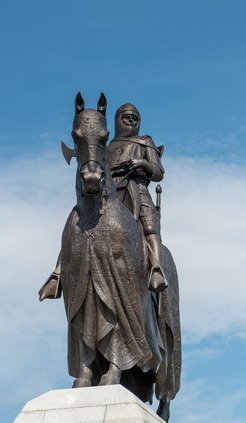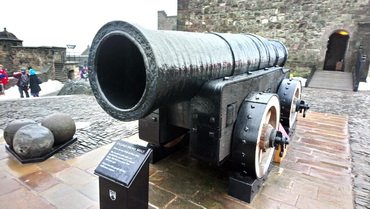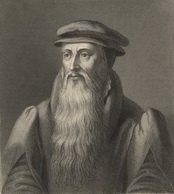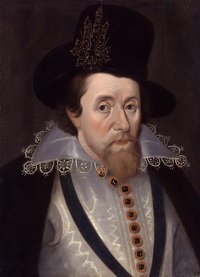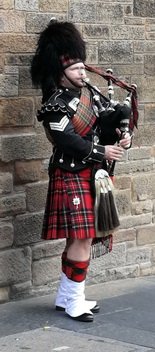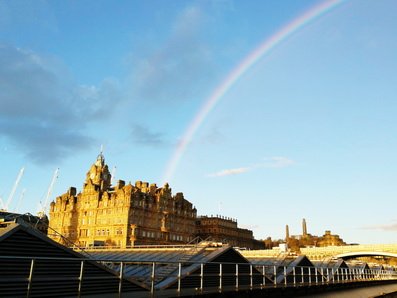T
he first people of Edinburgh were the proud people of a tribe called Goddodin. Who they were is not known, but they may have come from the great tribes of Indo-Europeans and Celts. They lived here in Dunedin. They had the privilege to fight with and against the Romans. They occupied the hill called today the Castle Rock, and when they perished in the sands of time the others have taken their place. Edinburgh grew from the top of where the castle is now, a place of an extinct volcano, going down and growing as lava goes down the hill. Then – it was just an observer of the creation of the Alba Kingdom further North.
When Kenneth MacAlpin united the Pictish clans of the North under one leader it was already IX c. Romans died away, leaving Europe to the Barbarians. Those first people that created Scotland were the blue-faced Picts, and the Scots from the West (coming probably from Ireland). Later the other tribes joined – the rests of Goddodin among them. MacAlpin became the king of the people – the Scots, and his land was called the Kingdom of Alba.
Time passed. The kings traveled around their land, uniting it, having multiple castles and strongholds. In the stability and strength of the Xth century, they decided that Dunedin will be their permanent home. But not anymore… In the new Anglo-Saxon language, it was now called Edinburgh.
It is not known when the conflict with the southern neighbor started but in XIII c. and XIV c. we have a period of Scottish Wars of Independence. A terrible time provoked by the loss of the power by Scottish nobles and the lack of a true and strong heir to the Scottish throne. In a time like that English king, Edward Hammer of the Scots (he was not called that yet) was asked to help, choose the king. He wanted to profit from the occasion… The war was a result and a few interesting things happened. Among them:
- Maybe the first declaration of independence – signed in Arbroath
- The most famous Scottish heroes – Braveheart
In the end, the Scots won their freedom. The new king – Robert the Bruce, happened to be a strong one, and from his blood came the most powerful line of Scottish kings – the Stuarts.
They line ruled for almost four centuries, and then some, and is famous for:
- The Golden Age and the Renaissance in Scotland
- The popularisation of whisky (James IV and Bonnie Prince Charlie & Highlands’ persecutions)
- The most tragic heroine – Marie Queen of Scots
- The most idiotic moves in the history of warfare (James IV and Flodden)
- Sitting on an English throne, starting with James VI/I
- And more…
The Golden Age (XIV and XV centuries) is what came first – Scotland grew and Edinburgh with it. The city became a capital having an international port in Leith.
But everything good doesn’t last forever – turbulent times came in XVI c. The monarchs became weak once again. King James V died, leaving the country in the hands of his French wife (Marie de Guise) and with an heir, who was a girl (Mary).
On the continent bad things started to happen as well – Martin Luther published his theses, not knowing that it was a spark that ignited the fire. The Reformation came to Scotland in the XVI century creating a rift between Catholics and Protestants. Between followers of the king and followers of the leaders of the people, between the friends of France, and friends of London.
The queen – Mary the Guise sent her daughter away to France, to keep her safe. She fought and finally died. The daughter, after her own adventures, returned at last in 1561 and became known as Mary Queen of Scots. A tragic queen that ruled with troubles for 5 years, married 3 times and spent almost 20 years in English prisons. Finally her cousin Elisabeth I executed her.
But her son managed the impossible and improbable – James VI became the king after the death of Queen Elisabeth in England. The Union of the Crowns happened in 1603, and the good times returned. The Protestant religion was safely anchored and people were happy.
Edinburgh managed to grow more until another disaster happened. The son of James VI wanted to return to the catholic religion. Civil war erupted, uniting Scotland, Wales, and Ireland and destroying the power of Stuart monarchs on the island. And after the wars – bad weather, famine and the lack of money. The only option was a closer union with London – the Union of the Parliaments happened in 1707. Scotland lost some liberties (like her parliament) in exchange for some benefits and opportunities coming from the south.
Then the first half of the XVIII century was marked by another civil war – Jacobites uprisings – the Stuarts wanted to return to the throne of London, and to overthrow the Hannoverian line. They didn’t make it. As a result, the Highlanders – who took the major part in the uprising suffered. The Scottish culture of the Gaelic language, clans, bagpipes, and tartans was almost destroyed or sent away to America or Australia.
The Age of Enlightenment was coming. University grew along with philosophy, medicine, and law. Those people, great minds – started to create Scotland with the beginning of the 1750s. The city grew and expanded from its hill with a castle to the other parts. Architects and inventors roamed the streets. Poets and writers emerged – crying after lost Scotland, and bringing its fame back. The fame that reached England, and which created an interest and a longing for the hills and the romantic fighters. Sir Walter Scott was the main character that preserved the Scottish culture with a stroke of a pen (e.g. Rob Roy) and then diplomacy.
Others joined:
- James Hutton, looking at the hills of Holyrood, wrote that the Bible is lying.
- James Watt wanted to upgrade an engine for it to work better.
- James Young Simpson got high and found a treatment for pain.
- And Graham Bell wandered around the New Town looking at the Castle Rock.
XIX century was truly a great time.
Later… we all know what came later. The great war that made the world small. Edinburgh had its small share, mainly in a lookout for the zeppelins flying over it in the direction of Clyde, where the shipyards were. Then the peace, the rebuilding, the growth, the return of the Parliament of Scotland, and a city that you want to know better. Not the Modern Athens, not the UNESCO city of Literature, but Edinburgh… old, wise Edinburgh with its Old Town and New Town, and its stories.
And if you want to know more history stories – head to the WALKS articles. There the ages brush over you as you visit the main sights of Edinburgh.

